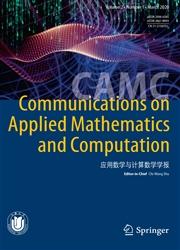拉格朗日理想MHD的非常规保散有限体积离散化
IF 1.4
4区 数学
Q2 MATHEMATICS, APPLIED
Communications on Applied Mathematics and Computation
Pub Date : 2023-11-06
DOI:10.1007/s42967-023-00309-2
引用次数: 0
摘要
本文构造了简化网格上更新拉格朗日理想磁流体力学(MHD)的一种非常规的保持散度离散化方法。以胞为中心的有限体积(FV)方法用于离散体积、动量和总能量的守恒定律,与模拟超弹性方程的方法严格相同。这种移动网格法通过构造保证了网格位移与由节点速度和所附单位角法向量求得的体积通量近似的相容性,该单位角法向量是单元体积对所考虑的节点坐标的偏导数。这正是符合几何守恒定律的定义,是任何适当的多维运动网格FV离散化的基石。利用单元面划分为子面和子面力的概念来近似计算动量和总能量通量,子面力是附着在每个子面上的牵引力,它撞击在一个节点上。我们观察到磁场的时间演化可以简单地表示为具有拉格朗日-欧拉映射特征的变形梯度。在这个框架中,由于皮奥拉公式,磁场的散度相对于时间是守恒的。因此,我们求解变形梯度张量的完全兼容更新拉格朗日离散化,以便简单地更新磁场的胞心值。最后,以节点速度表示子面牵引力,以确保每个单元内的半离散熵不等式。动量守恒和总能量守恒的恢复规定了在给定节点上撞击在子面上的所有子面力的平衡。这种平衡对应于一个由节点速度满足的矢量系统。它总是承认一个唯一的解,它提供了节点速度。通过多个典型的测试案例,验证了该方法的鲁棒性和准确性。最后,值得强调的是,一旦你有了一个更新的拉格朗日代码来求解超弹性,你也会得到一个几乎自由的更新的拉格朗日代码来求解理想的MHD,确保在离散水平上与磁场的对合约束完全兼容。本文章由计算机程序翻译,如有差异,请以英文原文为准。
An Unconventional Divergence Preserving Finite-Volume Discretization of Lagrangian Ideal MHD
We construct an unconventional divergence preserving discretization of updated Lagrangian ideal magnetohydrodynamics (MHD) over simplicial grids. The cell-centered finite-volume (FV) method employed to discretize the conservation laws of volume, momentum, and total energy is rigorously the same as the one developed to simulate hyperelasticity equations. By construction this moving mesh method ensures the compatibility between the mesh displacement and the approximation of the volume flux by means of the nodal velocity and the attached unit corner normal vector which is nothing but the partial derivative of the cell volume with respect to the node coordinate under consideration. This is precisely the definition of the compatibility with the Geometrical Conservation Law which is the cornerstone of any proper multi-dimensional moving mesh FV discretization. The momentum and the total energy fluxes are approximated utilizing the partition of cell faces into sub-faces and the concept of sub-face force which is the traction force attached to each sub-face impinging at a node. We observe that the time evolution of the magnetic field might be simply expressed in terms of the deformation gradient which characterizes the Lagrange-to-Euler mapping. In this framework, the divergence of the magnetic field is conserved with respect to time thanks to the Piola formula. Therefore, we solve the fully compatible updated Lagrangian discretization of the deformation gradient tensor for updating in a simple manner the cell-centered value of the magnetic field. Finally, the sub-face traction force is expressed in terms of the nodal velocity to ensure a semi-discrete entropy inequality within each cell. The conservation of momentum and total energy is recovered prescribing the balance of all the sub-face forces attached to the sub-faces impinging at a given node. This balance corresponds to a vectorial system satisfied by the nodal velocity. It always admits a unique solution which provides the nodal velocity. The robustness and the accuracy of this unconventional FV scheme have been demonstrated by employing various representative test cases. Finally, it is worth emphasizing that once you have an updated Lagrangian code for solving hyperelasticity you also get an almost free updated Lagrangian code for solving ideal MHD ensuring exactly the compatibility with the involution constraint for the magnetic field at the discrete level.
求助全文
通过发布文献求助,成功后即可免费获取论文全文。
去求助
来源期刊

Communications on Applied Mathematics and Computation
MATHEMATICS, APPLIED-
CiteScore
2.50
自引率
6.20%
发文量
523
 求助内容:
求助内容: 应助结果提醒方式:
应助结果提醒方式:


